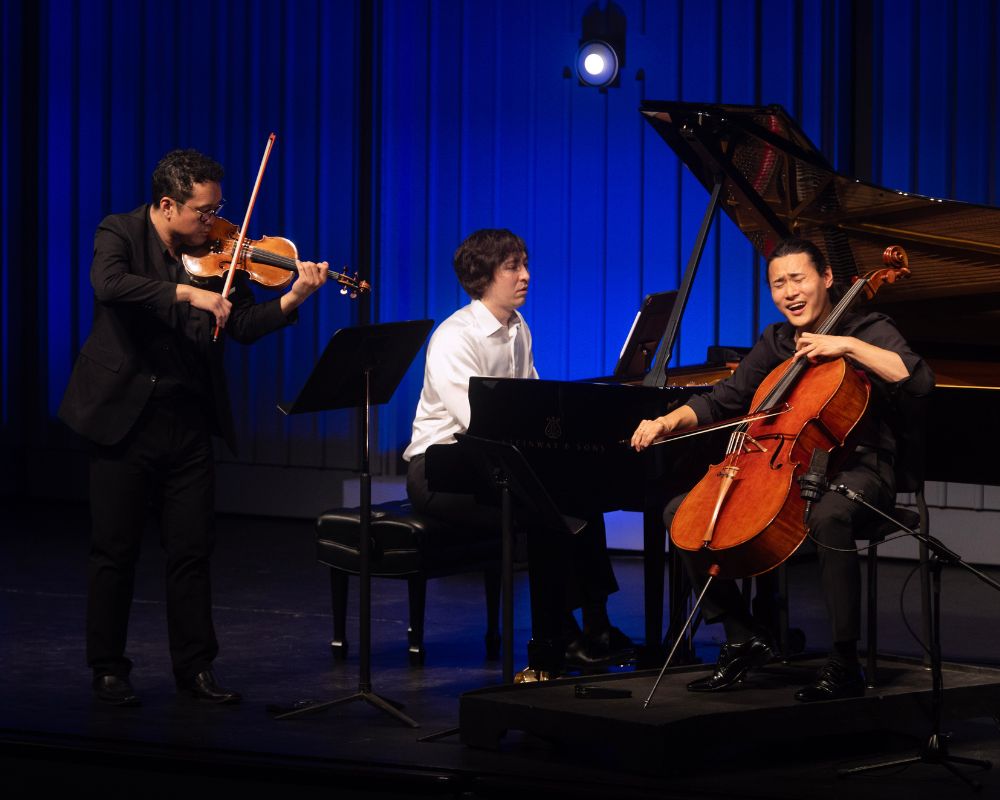
Trio Barclay
Mendelssohn’s Piano Trio No. 1
Sunday, October 6, 2024 at 5pm
Trio Barclay is Sponsored by
Eugene and Carol Choi
Mike and Ellie Gordon
Terry and Judy Jones
Karen Kuo-Limb and Jong C. Limb
Goran Matijasevic
Dot and Rick Nelson
Bob Romney
Richard and Cheryll Ruszat
Al Spector and Tatjana Soli
Ken & Sandy Tokita
Wes and Judy Whitmore
Charlie and Ling Zhang
This performance will include a 15-minute intermission.
Dennis Kim: Violin
Jonah Kim: Cello
Sean Kennard: Piano
JOHN CHRISTOPHER WINEGLASS:
ORCAS ISLAND: THE ROSE OF THE SAN JUAN ISLANDS FOR PIANO TRIO
I. SEA OF ISLANDS
II. QUIET SUNSETS
III. DOE BAY’S COVE
-INTERMISSION-
FELIX MENDELSSOHN: PIANO TRIO NO. 1 IN D MINOR, OP. 49
I. MOLTO ALLEGRO AGITATO
II. ANDANTE CON MOTO TRANQUILLO
III. SCHERZO. LEGGIERO E VIVACE
IV. FINALE. ALLEGRO ASSAI APPASSIONATO
Orcas Island, the largest of the San Juan Islands in the Pacific Northwest, served as the setting for the premiere of a previous chamber work that I composed for piano quintet at the 2023 Orcas Island Chamber Music Festival. This opportunity came as part of a broader tour across various cities and summer music festivals. During this visit though, I was deeply inspired by the stunning beauty of the San Juan Islands—particularly Orcas Island—as I approached by airplane on my first visit. It was in this moment that the concept for this composition took shape, initially as a piano trio with three movements, later adapted into a solo work for cello in a single movement.
The first movement, Sea of Islands, begins with a dark, repetitive 7/4 rhythm that persists throughout, evolving through several variations and key changes. This movement serves as a musical metaphor for the countless islands, both inhabited and uninhabited, that I witnessed from the air as I neared the island, just beyond the British Columbia coastline. The striking landscape and rich history of the area spoke to me powerfully, even before I set foot on its many trails and hikes. The initial sketches for this movement were created during that flight.
The second movement, Quiet Sunsets (and Sunrises), opens with the radiant and serene depiction of an Orcas Island sunrise, capturing the tranquility of the mornings and evenings I experienced by the lake and around various parts of the island. Tempo II (Sacred Sunset) of this movement reflects the sacredness of these sunsets, drawing inspiration from the reverence that Native Americans express toward natural phenomena—a sentiment I deeply resonated with during my time there. Tempo III (Sunset Hike to Mt. Constitution's Summit), as the title suggests, recounts a rewarding climb up Mt. Constitution in Moran State Park. From the summit, nearly half a mile above sea level, one is greeted with stunning panoramic views of the San Juan Islands, the highest point on Orcas Island and the second-highest peak on an ocean island in the lower 48 states.
The third and final movement, Doe Bay’s Cove, is named after the small, unincorporated community on the southeastern shore of Orcas Island. This movement carries a mysterious and atmospheric tone, reintroducing the familiar 7/4 pattern from the first movement, though it soon shifts into different time signatures and keys, often with abrupt modulations. Tempo II (Myop’s Return) is a brief thematic nod to my earlier piano quintet, …And The Summer Was Over, which led to my invitation to this extraordinary part of the world. The concluding meno mosso section features slurred, pulsating sixteenth notes in the first violin and piano, evoking the constant, rhythmic movement of the ocean waves that encompass this region.
- Program Notes by John Wineglass
Mendelssohn’s Piano Trio No. 1 in D minor (Op. 49) is one of the most well-known and beloved piano trios of all time. With works like this in the Romantic period, we began to enjoy chamber music as a standard genre in more intimate concert settings when virtuoso artists like Mendelssohn would share the stage, himself at the piano, with friends who were noted artists and composers in their own right.
This very trio was premiered with the violinist/composer Ferdinand David and Franz Witmann on the cello. The great Robert Schumann was present and immediately recognized it as the representative work of their time, placing it on par with Beethoven’s “Archduke” and “Ghost” Trios and what they embodied of the late Classical period.
The traditional structure reminds us, this served as a template for Schumann and Brahms’trios. The innovative engineering is a demonstration in creativity through immaculate discipline. It stands as one of Mendelssohn’s most celebrated masterpieces alongside his Octet (Op. 20) and A Midsummer Night’s Dream (Op. 61), from which the "Wedding March" is still the processional musical choice of brides around the world.
- Program Notes by Jonah Kim